Tomato plants are one of the easiest vegetable plants to grow and they produce delicious fruit all season long.
Just like all plants though, they require a specific amount of water. In general, tomato plants need about one-inch of water per square meter each week.
How often to water tomatoes?
Newly planted tomatoes should be watered generously to make the soil moist and to not stress out the plant.
Early in the season when they really start to grow, you can water your tomato plants in the morning to give them enough energy for the day.
So the big question is, how often to water tomatoes that you are growing yourself?
As temperatures rise, you might need to water the plants twice daily – to keep up with water loss.
The watering of tomato plants is not hard, so keep reading this post to get all the information you need to watering your tomato plants properly which include When, How Often & How Much you should water your tomato plants in pots or garden to keep them happy and thriving.
- Not enough water
- Too much water
- Soil draining the water too quickly
- Getting water on the leaves
How Do I Know My Tomato Plants Need To Be Watered?

Common problems with watering tomato plants:
Unfortunately, an answer like “once a day,” or something of the sort, is more or less meaningless, because so many factors influence how much water your tomato plant needs.
So, the real question is not “how often to water tomato plants,” but “how do I know when the tomato plant needs water —” and, how do you figure that out?
Here are few things to do to determine how much and how you should water your tomato plants most effectively.
Perform The Finger Test
The best way to determine if a tomato plant needs watering is by looking at the soil. Check the moisture of the soil and look to see if it is dusty or cracking.
Dig one of your fingers a couple inches into the soil to feel if the deeper soil feels moister than the surface. If the soil feels wet at all, wait for it to soak up more of the water before giving it any more.
Let Your Plant Determine When You Water It
Other than checking the soil, you can look to the stems of the plants for indicators. Feel the stem to determine if they are at all soft or limp – this can mean that you are overwatering your tomatoes.
On the flip side, if the stems are turning brownish or feel brittle, they plant needs more water.
Watch The Leaves
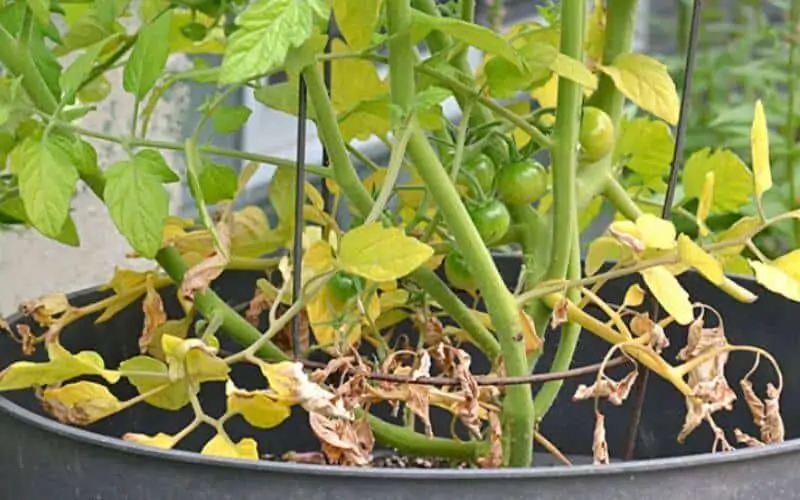
Yellowing of the leaves can signal overwateringPin
You can also look at the leaves to determine if the plant needs more to drink. Yellowing of the leaves can signal overwatering or water splashing onto the leaves during previous watering.
If they are brown and brittle, similar to the stems, they are not being watered enough. Also, if plants are being overwatered, the topmost leaves might start to curl inward and upward.
Watch The Tomato Fruits
Finally, you can look to the tomato fruit itself to see if the plant needs more water. If the skin starts to split, you might be watering the plant too much.
Further, you can check for flower blossom end rot (this is located on the bottom of the tomato fruit) – this means that you aren’t watering consistently but rather sporadically.
After cutting into the tomatoes, if they are watery and don’t have much flavor, consider watering plants less.
What Factors Determine The Watering Frequency?
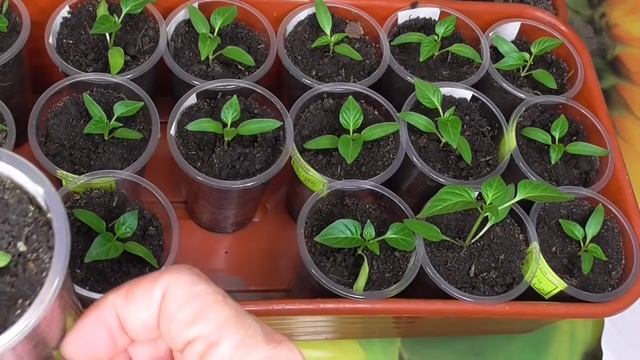
How And When To Transplant Tomato Seedlings From Seed TrayPin
Size Of The Tomato Plant
Not all tomato plants need the same amount of water. When the plants are seedlings, the soil tends to dry out much quicker because they are typically in small containers or trays. It is important to check the seedlings daily to make sure they don’t dry out.
But, the tomato seedlings don’t require that much water – spraying them with a spray bottle is the perfect amount that keeps the top of the soil moist.
Never let the seedlings sit in a puddle. If they are too watered, move them to a different spot that has more air flow.
When the seedling gets bigger, the will need progressively more water.
A good way to tell if they need to be transplanted into a larger container is if the soil in the small container or tray dries out in less than 24 hours.
Temperature Of The Day
In the beginning of the tomato plant growing season, water the plants in the morning so they are able to make it through the day with enough moisture.
When the temperature outside increases, this is especially important. If it is a really hot day, you might need to water the tomato plants twice a day.
Amount Of Rain The Tomatoes Are Exposed Too
Tomato On RainPin
Watch the weather forecast because it has a lot to do with how much water your tomato plants.
If there is rain on the way, you shouldn’t need to water the plants as much. This is important because you don’t want to overwater the plants.
If The Garden Has Mulch
If your garden has mulch surrounding the tomato plants this can also affect the amount of water that they need.
Mulch works to retain moisture in the soil, so ideally, the soil won’t dry out as fast as if they didn’t have mulch.
Adding organic mulch to the surrounding of the tomato plants reduce evaporation in the soil.
Where They Are Planted (I.E. Containers Or Garden)
It is well known that tomato plants grown in containers need more water than garden tomatoes. This is because the containers heat up more quickly which leads to more water evaporation.
How Often Should I Water My Tomato Plants?
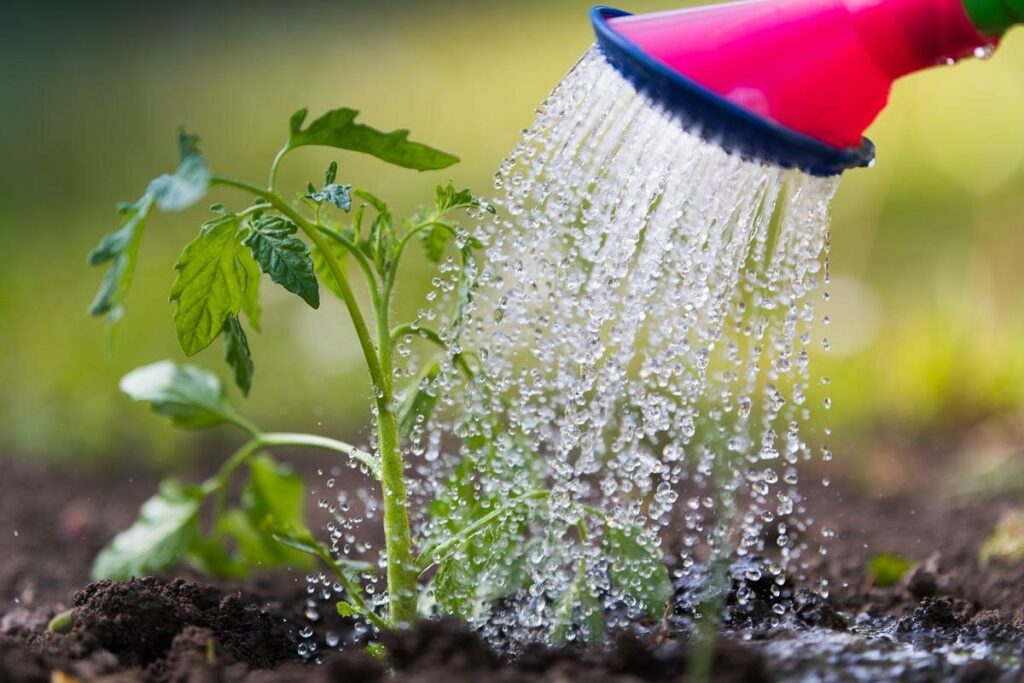
The biggest and most important thing to remember that every plant is different. Weather conditions are different and soil brands have different levels of soil retention.
The best way to give your tomato plants the best life is monitor them closely.
In the thick of summer, tomato plants should be watered two to three times each week. Temperature and sunlight are the determinates of how often tomato plants need to be waterer, because when they receive more sun and the temperature is warmer, water is evaporated faster – so you need to water them more regularly.
When the temperature starts to decrease at the end of summer and into fall, you can cut back the watering to once a week.
Plants need an even supply of water as well. Irregular watering may cause issues with them as the season progresses. Try to water them eat the same times every day and each week.
How Much Water Do Tomato Plants Need?
There is not specific amount of water that tomato plants need. There are numerous factors that can influence the individual requirements of specific plants.
You need to monitor your tomato plants closely and know the signs of under and overwatering.
If you are worried about your watering frequency or amount, you can use a water gauge to tell you when the soil is dry and the plant needs water.
At the very least, tomato plants need at least one inch of water (from manual watering and/or rain) each week in order to have a steady production of fruit.
On average, this measurement equals about 60 gallons of water for every 100 square feet of garden. As the temperature gets hotter and drier, the plants start to need at least two inches of water per week.
How Often To Water Tomato Plants In Pots?
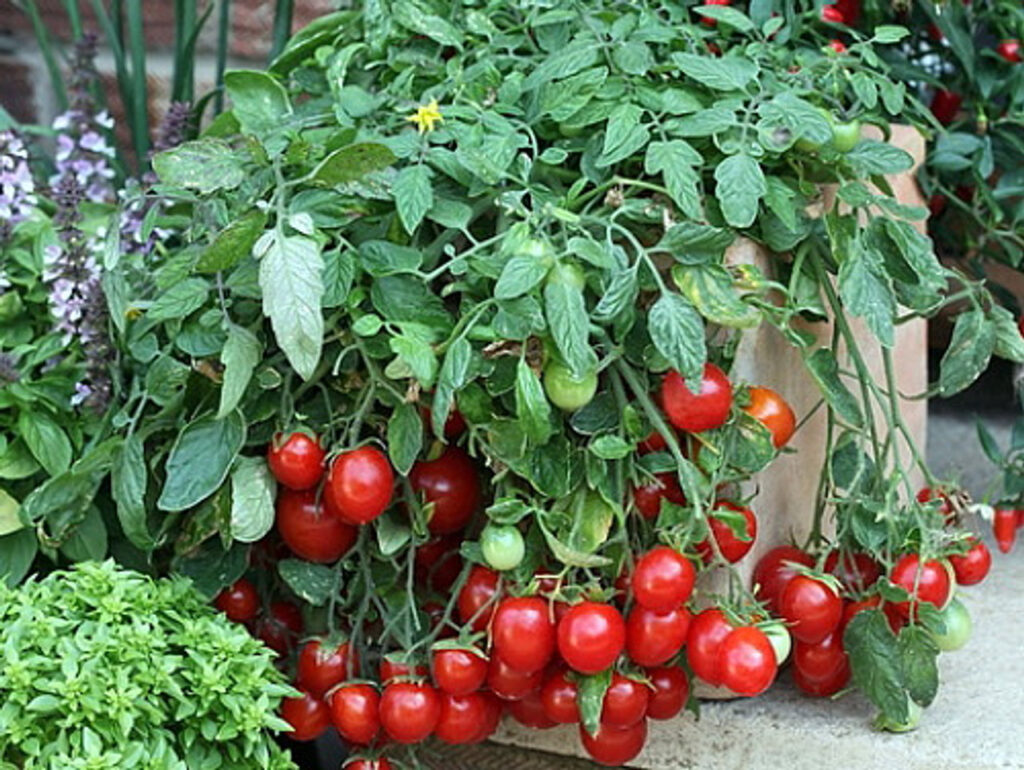
Water More, But Less FrequentlyPin
As mentioned earlier, tomato plants grown in containers need more water than those grown in gardens.
This is because the container plants get hotter faster leading to increased evaporation.
First things first, your containers need to have drainage holes so that you don’t drown the plants in water.
However, that doesn’t mean that you can water as much as you want because every time water drains, it brings some essential nutrients in the soil with it.
Your plants will be much happier if you water them the appropriate amount.
What’s more, when it comes to tomatoes, the bigger the container the better. When you have a larger container, the soil holds the water better.
So, what is the appropriate amount?
Unlike tomato plants in gardens, there are no specific guidelines for container plants. Instead, you have to monitor them to make sure that the soil is moist and water them when it is not.
You can use the outside temperature to determine how often to water the plants. Anecdotally, some people suggest to water them once in the morning, and then if it is a really hot day, water them again (just a small amount) in the afternoon if they have dried out.
When Is The Best Time To Water Tomato Plants And When Is The Worst?
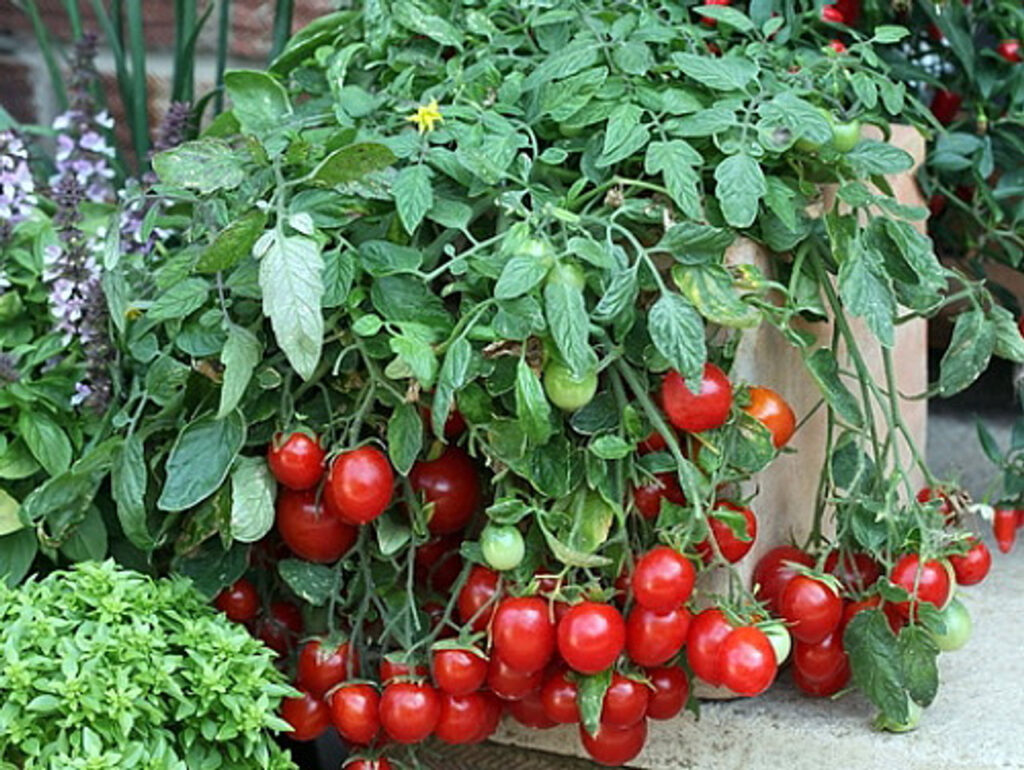
Do I Need To Stake Or Cage A Tomato Plant In A ContainerPin
In general, the best time to water tomato plants is in the morning so that they have enough water to quench their thirst throughout the day.
Watering in the morning also cuts down on evaporation losses so plants stay hydrated longer. This fortifies them so that they can have a productive day producing leaves, flowers, and fruits.
Is It OK To Water Your Tomato In The Middle Of The Day?
Some gardeners however, swear by watering the tomato plants in the middle of the day. This is because in the middle of the day when the sun is at its peak, the leaves dry quicker because of the heat.
This increases humidity around the plants and cools the leaves. When leaves are cooler, there is less water loss through them which prevents midday wilting.
The consensus seems to be not to water the tomato plants in the evening. Watering at night increases the chances that water could remain on the plants leaves and in the soil (because of the cooler air temperature), which can lead to leaf-spotting fungi, leaf-blighting, root loss and stunted growth.
Guidelines And Tips On How Best To Water Tomato Plants
Watering tomato plants can be tricky and they need to be taken care of. If you follow these guidelines and tips, you will be sure to grow healthy, juicy, red tomatoes.
Water Slowly And Water Deeply
The most important rule in tomato plant watering is go slowly and make sure the water sinks deep. Never rush watering.
Rushing the process might flood the plant and cause unnecessary stress. Flooding also leads to excessive runoff where valuable nutrients can exit the soil.
One recommendation is to soak the soil so that 6-8 below the surface becomes moist. This promotes healthy root growth which increases stability of the tomato plant and improved overall regular production (leaves and fruit).
Water Regularly
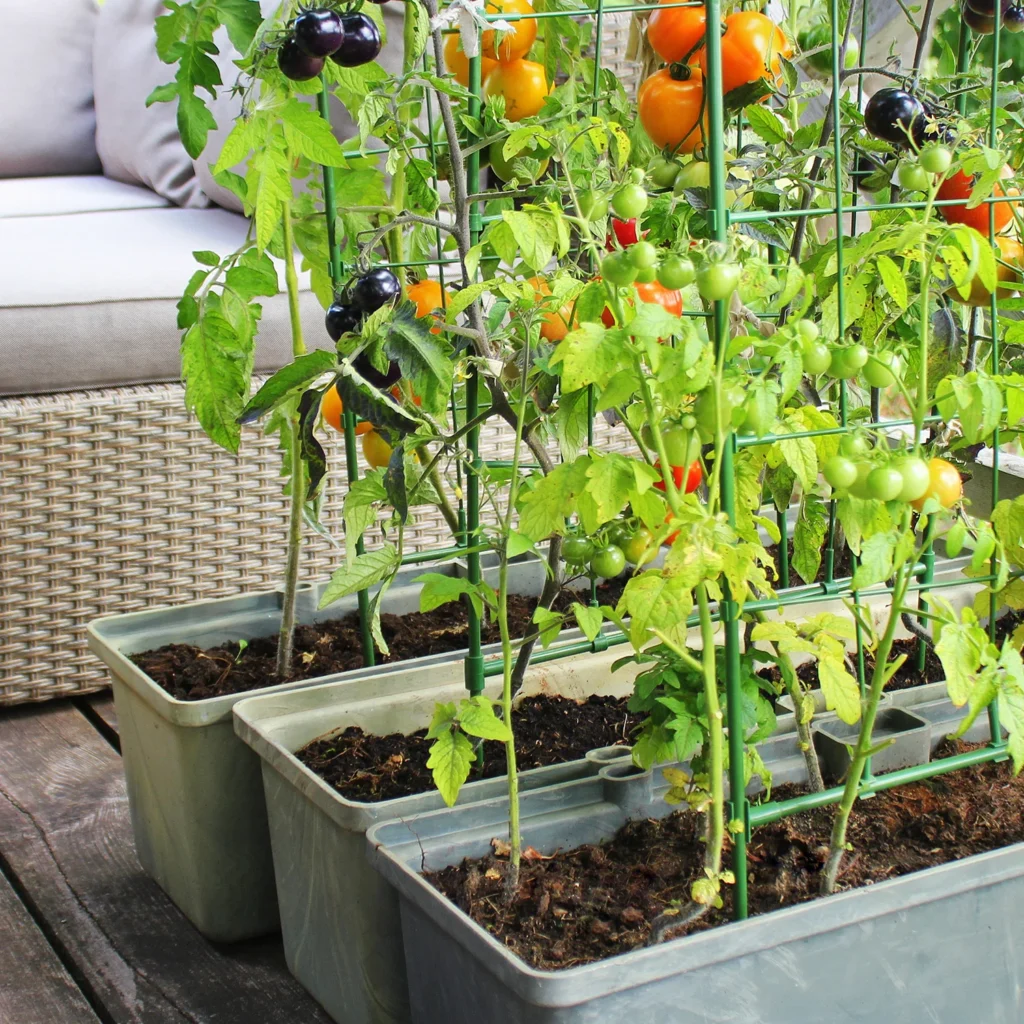
Watering Tomato PlantPin
There is no perfect formula that you can adopt for watering tomato plants. It all depends on many factors and what the plant needs itself. Watering regularly is important but may take some experimenting.
Monitor your growing plants and watch to see when they dry out. Know your region and understand that the temperature of your area significantly influences when your plants will need watering.
Should you water tomato plants everyday?
A good rule of thumb is to water two or three times per week when the temperature is fairly consistent. Remember though that if it is extremely hot on certain days, watering twice might be necessary. Try to follow a rough schedule every week (for example, water on Mondays, Wednesdays and Fridays) and alter it as needed.
Water Only When The Plant Needs It
Watering too much is a problem for some people. They get stuck in their watering schedule and forget to watch the plants for signs of water loss.
It is true that tomato plants like moisture but overwatering can be extremely harmful. When soil is soggy or too wet it can prevent the roots from getting the nutrients that they need from the air.
If the leaves of the tomato plants look wilted in the afternoon on a hot summer day, this is completely normal.
This is a reflex and they will most likely perk up overnight. If they are still wilted in the morning, you can safely guess that they need more water.
Water Early In The Day
Watering in the morning is hands-down the best time to water tomato plants. Gardeners all over agree on this and it is because it gives tomatoes enough moisture to last the entire day (except for extremely hot days).
Do not water your tomato plants in the evening. Because it cools off at night, there is a greater chance of the water remaining on the leaves.
If the leaves stay wet for more than three hours, they become more susceptible to leaf-blighting and leaf-spotting fungi.
Try Watering Using Drip Method
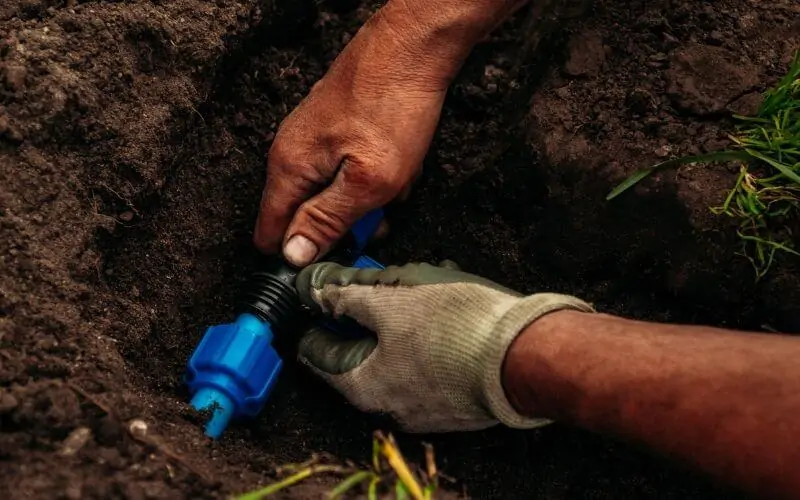
drip irrigation system in tomato fieldPin
This tip ties into the water slowly guideline. Many gardeners use this method, especially if they are going to be away from their plants for an extended period of time and need to have some system to water them when they are away.
This is a system where water is slowly let out of a tube/hose so that the soil has enough time to soak everything up and retain that moisture. This prevents flooding and water loss.
You can buy and install a drip water irrigation system that can be set up on a timer so that the plants get water regularly.
This can become a bit more than amateur gardeners wish to deal with so alternate DIY (do-it-yourself) methods can be utilized.
This includes poking holes in a plastic bottle and digging it into the soil and leaving the top of the bottle poking out.
You can fill the bottle up as needed and water will slowly seep into the deep soil. Be careful not to disturb the root system when digging a hole to put the bottle in though.
Water At The Roots
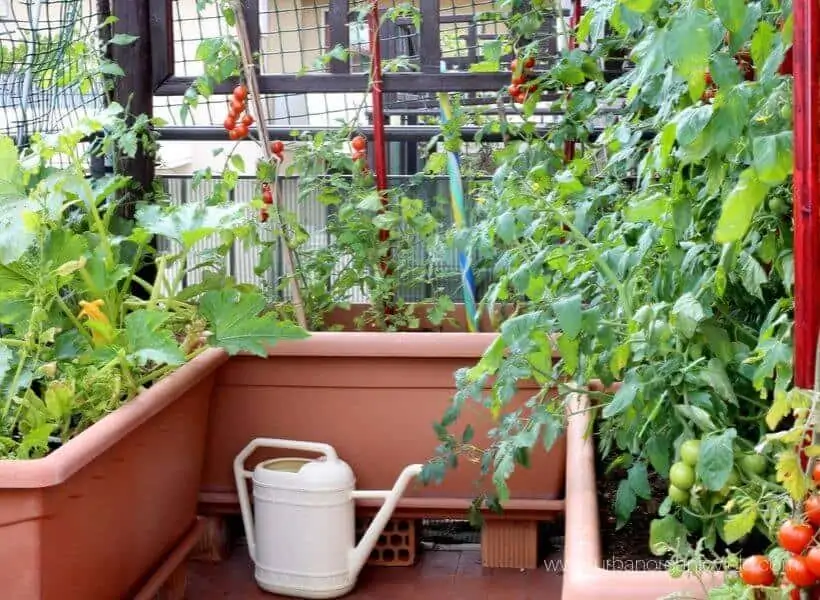
Water More, But Less Frequently (1)Pin
The roots of the plants are where the water gets sucked up. It is crucial that you water close to them so that they get access to the water.
Watering over the leaves is a dangerous thing to do because if they water remains on the leaf this can cause numerous problems.
It is best to water at the base of the plant and try not to let the water splash up onto the leaves.
Mulch is a gardener’s secret weapon. It adds organic matter to the plant and it prevents excessive evaporation. Mulch is an organic layer of leaves, hay, coconut husk, wood, pine cone pieces, etc.
It decays over time and becomes nourishment for the plants, providing essential nutrients helping it stay healthy.
Mulch increases water retention. If you notice your plants drying out regularly, consider using mulch to prevent this water loss.
It also increases the room for aeration when it is lightly mixed with the top soil. This ensures that the roots will be able to get the airflow that they need.
Water Generously After Transplanting
How To Transplant Tomato Seedlings To The Garden_Pin
After transplanting seedlings into the garden, it is easy for them to become stressed out. To prevent this unnecessary stress, which can cause wilting and stunted growth, generously water the plants when you first put them in the ground.
Try Using Enlivened Water
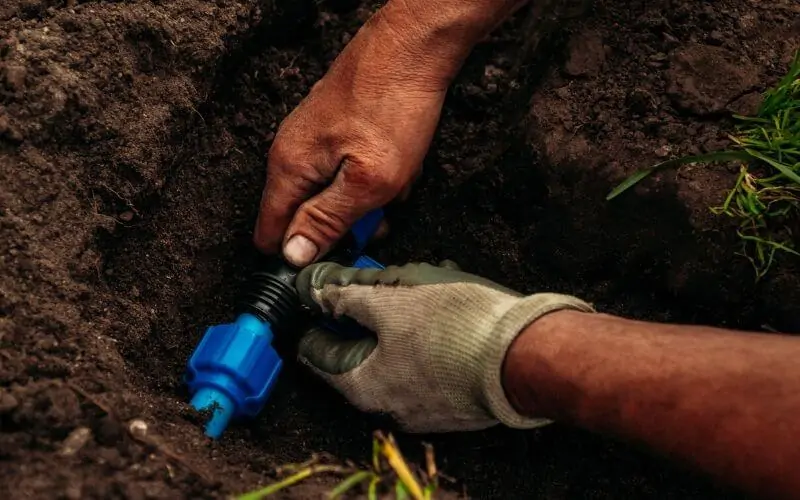
Now this method has been deemed “crazy” by some, it is backed by some science. This is an ancient method where the water is stirred clockwise about 50 times.
This adds energy to the water (because it is moving). It is said to help plants grow healthier.
Consider trying this method and recording what changes you see in your tomato plants.
Keep A Watering Journal
Like mentioned above in the post, monitoring your tomato plants is really what is needed to determine who much and when to water them.
Each year, if you find yourself forgetting about the experiments that you performed and the successes that you had, try keeping a journal to record everything.
Every plant is different and they all require attention so why not give formal recording a try.
Conclusion
Watering tomato plants isn’t an exact science but it is something that can be done effectively.
Every plant is different, soil is different, temperatures are different – there are so many factors that influence the growth of our plants.
Give them the attention that they need and monitor their health and they will be happy and produce fruit all season long.
